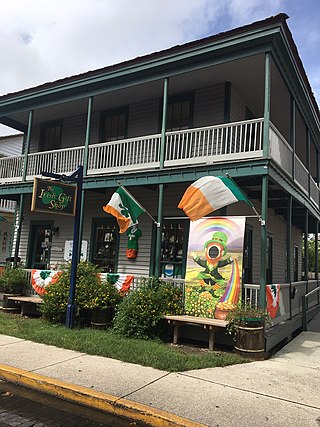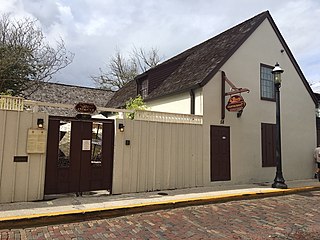
The St Augustine Town Plan Historic District is a U.S. National Historic Landmark District encompassing the colonial heart of the city. It substantially encompasses the street plan of the city as contained within the bounds of walls built between the 16th and early 19th centuries. The district is bounded by Cordova, Orange, and St. Francis Streets, and Matanzas Bay. It was designated a National Historic Landmark in 1970, although its boundaries were not formally defined until 1986.

Ximenez-Fatio House Museum is one of the best-preserved and most authentic Second Spanish Period (1783-1821) residential buildings in St. Augustine, Florida. In 1973, it was added to the National Register of Historic Places. It was designated a Florida Heritage Landmark in 2012.

The Spanish Military Hospital Museum is located at 3 Aviles Street, St. Augustine, Florida. The museum covers the Second Spanish Period (1784-1821) medical practices. The museum is open seven days a week from 9am to 5pm. Tours start on demand throughout the day and cover a surgical demonstration, apothecary demonstration, and tours of a medicinal herb garden.

Government House, also known as Governor's House, is located at 48 King Street in St. Augustine, Florida, adjacent to the Plaza de la Constitución. The building, constructed of coquina, served as the governor's official residence from c. 1710 during the First Spanish Period (1565–1763), throughout the British Period (1763–1784), and until 1812 in the Second Spanish Period (1784–1821). Governor Gonzalo Méndez de Canzo was the first governor to build his residence on the present Government House site in 1598.

The Oliveros House is located at 59 St. George Street, St. Augustine, Florida. It was built of coquina during the Second Spanish Period in Florida (1565-1763). Today it is a reconstructed building, standing on original foundations which were unearthed during archaeological excavations.

The Benet Store is located at 62 St. George Street, St. Augustine, Florida.

The Wells Print Shop was located at 27 Cuna Street in St. Augustine, Florida. It operated as part of the Historic St. Augustine Preservation Board's 18th century museum village, San Agustín Antiguo, demonstrating the colonial printmaking process.

The William Watson House is located at 206 Charlotte Street in St. Augustine, Florida. It is a reconstructed property representing the architecture of St. Augustine's British Period (1763-1784).

The Historic St. Augustine Preservation Board (HSAPB) was a state agency in Florida that participated in the restoration and preservation of historic buildings in St. Augustine, Florida from 1959 to 1997. Created in 1959 by Governor LeRoy Collins, the agency acquired, restored, and preserved historic structures in St. Augustine until its abolishment by the State of Florida in June 1997.

The Gallegos House is located at 21 St. George Street in St. Augustine, Florida. It is a reconstructed property demonstrating a typical home of Florida's First Spanish Period (1565-1764).

The Old Blacksmith Shop is located at 26 Charlotte Street in St. Augustine, Florida. It is a reconstruction of an outbuilding located on the site during the British possession of Florida.

The Sánchez de Ortigosa House is located at 60 St. George Street, St. Augustine, Florida. It is a reconstruction of a home dating from the First Spanish Period (1565-1763) that stood on this site.

The Arrivas House is located at 46 St. George Street, St. Augustine, Florida. It was the first completed restoration project of the Historic St. Augustine Preservation Board (HSAPB), and was named after early owner Don Raimundo de Arrivas.

The Cerveau House is located at 26 Cuna Street in St. Augustine, Florida. It is an original house, constructed in the 19th century.

The Gómez House, located at 27 St. George Street in St. Augustine, Florida, is a reconstruction of a simple wooden house dating back to Florida’s First Spanish Period (1565-1763).

The De Mesa-Sánchez House is located at 23 St. George Street in St. Augustine, Florida. It is a restoration of a home dating back to East Florida's First Spanish Period.

The Luciano de Herrera House is located at 58 Charlotte Street in St. Augustine, Florida. It is a reconstruction, depicting a house from St. Augustine's Second Spanish Period (1784-1821).

The Joaneda House is located at 57 Treasury Street in St. Augustine, Florida. It was restored to be an example of a Second Spanish Period (1784-1821) residence. It is one of the oldest buildings in Florida.
William Lee Sims, II was an American businessman, farmer, and philanthropist.

The Paredes-Dodge House is located at 54 St. George Street in St. Augustine, Florida. The one and a half story structure was built between 1803 and 1813, and is one of the only surviving colonial structures in St. Augustine.




















